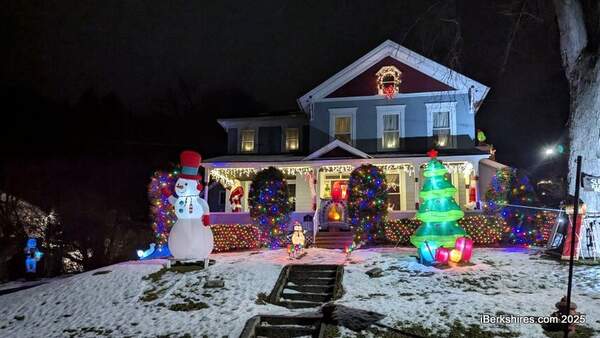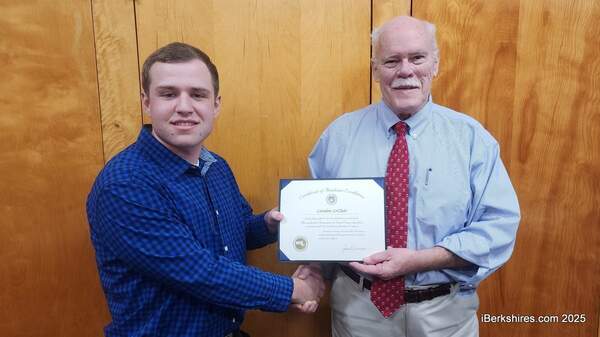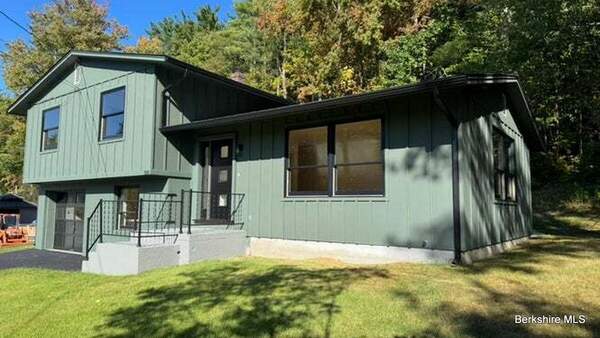Before the Chutes, Hoosic Floods Raged
 |
| A crowd gawks at the damage caused on Melrose Street in Adams by the 1938 Hoosic flood. (Photo courtesty of Adams Historical Society) |
Editor's note: This is the fourth in a series of articles about the Hoosic River, in conjunction with the second annual "Hoosic Moments" writing contest. Contest details below.
Industries grew along the Hoosic River in the 19th and 20th centuries, using it for power and waste disposal. The area grew and prospered. Every so often, however, nature rebelled, and floods ravaged the area, washing out roads, dams, bridges and houses.
On Oct. 4, 1869, in North Adams, after a full day of rain the previous day, mill dams started to collapse, and then bridges, streets and houses were carried away. In all, $100,000 in damage was estimated at the time.
Adams was hit by a two-day "cloudburst" on Aug. 19 and 20, 1901. The Basset Reservoir Dam and Dean's Dam burst. One man drowned. Among the industries, the Berkshire Mills suffered the most damage, but Renfro Company and many smaller businesses were hit very hard. Some houses were torn from their foundations, many others damaged. Streets and railroad track lines were badly washed out all around Adams. The total damage estimate was $250,000 in Adams, $10,000 in North Adams and "several" thousand dollars in Williamstown. Days later, the street crew found the Murray Street Bridge and another bridge that had been washed away in the flood.
There was another flood in 1922, but a disastrous one struck on Nov. 3 and 4, 1927. At the time, it was considered the worst flood ever. Six point 11 inches of rainfall was recorded over 36 hours, the greatest in the 50 years of record keeping to that date. In North Adams, the Marshall Street Bridge was swept away. Several houses, including 10 in Willow Dell, were washed away, as were several garages on River Street. A Ford car was washed through a second-floor window into the Hoosic Cotton Mill. Damage to industries was heavy. Total damage was estimated at $2 million. Heroic rescue efforts of policemen and firemen were credited with preventing any fatalities.
The flood of March 18, 1936, was relatively less serious. A mudslide crushed a house and garage on West Main Street in North Adams. Sixty families were left homeless in Adams, and bridges were reported lost. Broad Brook and the Green River damaged roads and bridges in Williamstown. Area wide, the damage estimate was put at $100,000.
The hurricane of September 1938 caused severe wind damage and dropped 6.9 inches of rain over a three-day period. In Adams and North Adams, two deaths occurred and many injuries were suffered. About 300 people were left homeless. Water mains broke, and power was knocked out when poles collapsed. The West Shaft Road Bridge was lost. In Williamstown, there was Green River and Broad Brook flood damage, including the total destruction of the Wally Bridge. All together, the storm toll was put at $2.5 million.
Disaster struck again on Dec. 31, 1948. Over 8 inches of rain fell over a three-day period, In North Adams, the Phelps Avenue and Protection Avenue bridges were destroyed; the Petri Cleaning Store on Eagle Street collapsed into the river. Damage to houses in the Greylock section, Front Street, Brooklyn Street and Beaver Street was the worst. All pavement from Wood Street ended up at the Blackinton Mill. Damage in North Adams was put at $1.2 million.
After the 1948 flood, local and state officials, especially Mayor James A. Bowes of North Adams and U.S. Rep. John W. Heselton, stepped up pressure on the federal government to move on flood-control proposals. In 1950, Congress approved flood control projects of $5.1 million for Adams and $14.8 million for North Adams. Those projects were completed in 1959. Ironically, since 1949, there have been no major flood-flow events to protect against, despite a few major rainfalls. The reasons for this are not known.
Tom Ennis is president of the Hoosic River Watershed Association. He thanked the following organizations and people for contributing information for this article: The Williamstown and Adams Houses of Local History, the Williams College Congressional Record depository, the North Adams Public Library, the North Adams Transcript archives, and Professor David Dethier of Williams College.
Tags: flood control, flooding, historical,















